Numerous high-end timepieces can illuminate in low-light conditions, including most models from Rolex. As one of the most expensive brands, Rolex is known for its innovation and craftsmanship. Have you ever wondered how Rolex watches glow up in the dark?
This feature enhances the watch’s visual appeal and offers practical utility. However, it’s crucial to discern between the luminous materials used.
Super-LumiNova, crafted from strontium aluminate, is a non-radioactive substance, while Chromalight is Rolex’s proprietary luminescent material. What, then, contributes to a watch’s glow in the dark? Let’s answer the question through this article.
Table of Contents
ToggleHow Your Rolex Watches Glow in the Dark
A particular technology is employed in crafting timepieces capable of luminescence. We invite you to view our enlightening video below to unveil the secret behind this innovation.
Understanding the Super-LumiNova
Super-LumiNova is the critical player in creating that mesmerizing glow-in-the-dark. This material is mixed with phosphor, letting it soak up light energy and slowly release it, giving off a soft glow when it’s dark outside.
What’s cool about glow-in-the-dark objects is that they can shine in different colors, depending on what they’re made of. Phosphors, the substance that makes things glow, can produce greens, blues, or even reds.
Rolex introduced Super-LumiNova in the early ’90s as a significant innovation. Specifically, this luminescent material finds application within the esteemed Rolex Submariner collection.
Unlike older models that used radioactive materials like radium and tritium, Super-LumiNova is made of non-radioactive strontium aluminate. It shines brighter and lasts longer, making it a hit among Rolex fans.
Why Do Rolex Submariners Use Super-LumiNova?
Rolex actively chooses Super-LumiNova for its timepieces, extending its purpose beyond enhancing luminescence for low-light visibility. This material choice yields several favorable outcomes.
1. Intense luminosity
The luminescent feature of the watch not only adds visual appeal but also fulfills a functional need.
Rolex incorporates Super-LumiNova into the Submariner for its ability to emit intense, enduring light in the darkness, guaranteeing optimal visibility of the hour markers and hands, even in the ocean’s depths.
Designed for daring divers confronting demanding conditions, the Submariner utilizes this highly effective material to prioritize functionality.

2. Durable and water-resistant
Super-LumiNova boasts remarkable durability, making it an ideal choice for Rolex timepieces such as the Submariner, frequently encountering deep-water environments with high-pressure conditions.
Its resilience ensures longevity even in water exposure, temperature variations, and UV radiation, preserving its luminous qualities over time.











3. Rechargeable
Super-LumiNova possesses the distinctive attribute of being rechargeable, offering a practical advantage to timepiece owners.
When exposed to natural or artificial light sources, this material absorbs and stores light energy, ensuring sustained visibility in dimly lit environments over an extended period.
This inherent capability eliminates the need for frequent battery replacements or reliance on external power sources, enhancing the convenience and longevity of the watch’s luminous function.
Do All Rolex Watches Use Super-LumiNova?
Not limited to the Submariner, Rolex has extended the application of Super-LumiNova to other models such as the Explorer and GMT-Master II. However, in 2008, Rolex unveiled its proprietary luminescent material, Chromalight.
Unlike Super-LumiNova, crafted from non-radioactive strontium aluminate, Chromalight is an exclusive innovation from Rolex. The key distinction lies in their luminous performance. Chromalight surpasses Super-LumiNova in brightness and longevity.
While Super-LumiNova’s radiance diminishes significantly after several hours, Chromalight persists for up to eight hours, providing enhanced visibility in low-light conditions.
Differences Between Chromalight and Super-LumiNova
Indeed, there’s a rationale behind Rolex’s decision to persist with Chromalight while discontinuing the use of Super-LumiNova in their latest releases. Let’s explore the distinctions that set Chromalight apart from Super-LumiNova.

1. Additional pigments to get more color
In reality, Chromalight bears striking similarities to Super-LumiNova. This material amalgamates various Super-LumiNova pigments to achieve shades such as blue.
Its distinct hue on the color spectrum enhances visibility in low-light conditions, remaining as enduring as green Super-LumiNova but appearing brighter due to its coloration.
This distinction becomes apparent in the glowing color of both Super-LumiNova and Chromalight. Super-LumiNova emits a green hue in the absence of light, whereas Chromalight radiates in various shades of blue.
2. Different manufacturing process
Rolex’s exclusive Chromalight display begins with an ultra-fine metal oxide powder comprising aluminum, strontium, dysprosium, and europium. This powder undergoes a meticulous manufacturing process to achieve the required blend of materials.
Initially powdered, the luminous material possesses light-emitting properties but lacks the feasibility of application needed for watch hands and hour markers.
The luminous powder is transformed into a liquid paint to make it suitable for the intricate surfaces of watch components.
Chromalight is used in many Rolex watches, especially in their Professional series. Some Rolex watches that use Chromalight are the Submariner, Sea-Dweller, Deepsea, Yacht-Master, and GMT-Master II.
For those interested in acquiring Rolex timepieces equipped with Chromalight, kindly visit Luxehouze‘s website or boutique in Jakarta, Surabaya, or Singapore is recommended.
Rest assured, every Luxehouze item is guaranteed to be 100% authentic, premium, and available at competitive prices. Don’t miss the opportunity to elevate your collection with a Rolex watch from Luxehouze today!












